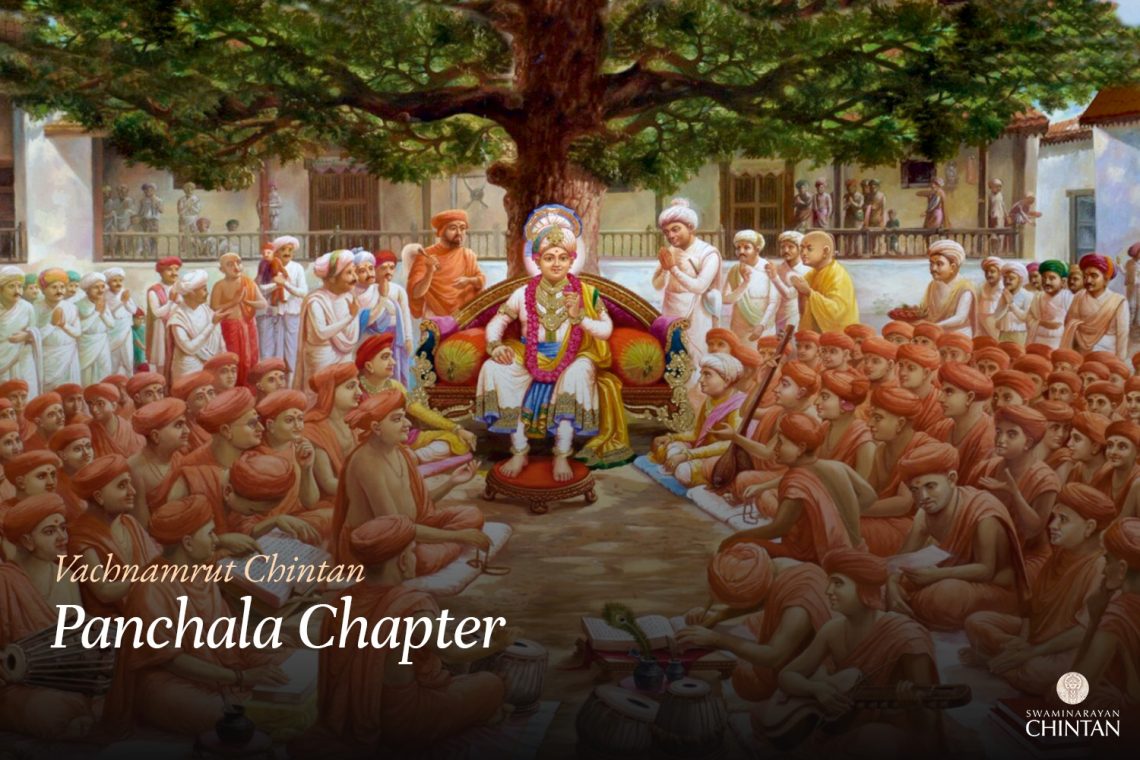Central Insights:
- Understanding the nature of Bhagwan.
Main Points:
- There are absolutely no Mayic qualities in Bhagwan.
- Whatever Bhagwan displays is like the illusion of a rope trick charmer. One should understand that Bhagwan is supremely pure.
Commentary:
This Vachanamrut is centered around the analogy of the rope trick charmer. Just as a rope charmer performs illusions before a king, first tying his weapons and climbing into the sky to fight the demons, the enemies of Indra, and then falling in pieces to the ground, with his wife collecting the body parts and burning herself on his funeral pyre—only for the charmer to return later, fully armed, asking the king for a reward and demanding the return of his wife—the king is baffled. The charmer reveals his wife, who had been hiding under the king’s throne all along. The king and all the spectators are left in awe, unable to comprehend what the charmer had done or how he did it. Even though the charmer seemed to have died, he never really did.
Maharaj then explains, “What is the nature of Bhagwan? The verse यत्र त्रिसर्गो मृषा — yatra trisargo mṛṣā which means that the Maya of the three attributes — the bhut, Indriyas, Antahkaran, and the presiding deity — do not exist in Paramatma at any point in time. So, when Paramatma appears in human form, how should one understand what is seen? It may appear that He falls ill, becomes afraid, takes sides, quarrels, or even kills someone. But how should we interpret all this?”
The same illusions seen in the charmer’s performance are witnessed here as well. He seemed to have died, was burned, yet returned as though nothing had happened, leaving everyone unable to comprehend the truth. Similarly, if such things appear in Bhagwan, there can be two reasons for it. Either the observer’s mind has been confused, like when a jaundiced person sees everything as yellow, or someone wearing colored glasses perceives everything in that color, even though the actual objects are not like that. Or, it may be that the one showing these actions is a supreme trickster, like a great magician who can make thousands of people see what is not actually there and can also conceal the reality.
Just as the Ved, Shastra, and those who truly know Paramatma state, “Yatra trisargo mṛṣā”—in Paramatma, the creations of Maya never exist. So, when such things appear, one should investigate what caused them to appear. In Bhagwan, not only do these qualities not exist now, but they never will in the future either.
Furthermore, the verse धाम्ना स्वेन सदा निरस्तकुहकं सत्यं परं धीमहि | —Dhāmnā svena sadā nirasta-kuhakaṃ satyaṃ paraṃ dhīmahi (Bhagavat1-1-1) means that Bhagwan, with His own divine form, has cast aside the deception of Maya. He is the Supreme Reality. At the end of the ultimate dissolution, the form of Bhagwan in Akshardham is supremely pure and endowed with infinite divinity, and we should know that the human form of Bhagwan is equally divine. Only when one understands Bhagwan in this essence can they be said to have truly known Him.
When Bhagwan appears in human form, He seems to go through birth, childhood, youth, and death. This is what the ignorant see, and Bhagwan shows them this. However, if one brings faith in the words of an Ekantik Sadhu and sincerely worships at the lotus feet of Bhagwan, their Mayic perception fades away. Then, the very same form of Bhagwan appears as Sat, Chit, and Anand—the supreme conscious form, full of existence, knowledge, and bliss. The human traits that appear are merely His Yogmaya. In reality, Bhagwan is exactly as He always is—eternal, undivided, and indivisible. For example, when Shree Krishna Bhagwan left His body and Rukmini and the other queens became sati along with His body, those with a Mayic perspective believed that Bhagwan had died. However, those with divine vision knew that He had merely disappeared from this material realm and manifested elsewhere. Similarly, when Maharaj left His body, Dadakhachar was overwhelmed with grief, but Gopalanand Swami sent him to the garden, where Maharaj was seated in an assembly. When Gunatitanand Swami fainted in grief, Maharaj instantly sat him up and scolded him, asking, “Do you think I have died? Do you believe I can die?”
Therefore, such attributes do not exist in Bhagwan in any of the three phases of time—past, present, or future. However, ignorant individuals who see Bhagwan in His manifest form either believe Him to be just like a human or think of His form as being a creation of Maya if they consider Him to be formless. Without truly understanding Bhagwan, they fall into misunderstanding in both ways. Bhagwan is always manifest in a form, and whenever He assumes a form for a particular purpose, even that form becomes divine.
Just as fire enters iron and suppresses its black color and cool touch, causing the fire’s nature to manifest instead, or just as when the sun rises, even though the stars and the moon are still present in the sky, their light is absorbed and overshadowed by the brilliance of the sun, Bhagwan similarly enters whatever He chooses and absorbs that entity into Himself, revealing only His divine nature. When Bhagwan departs, the entity returns to its original state, and the boundless divinity that was visible was, in fact, only the manifestation of Paramatma.
So, what is the nature of Bhagwan? It is like a coconut filled with sweet water; inside, you can see the water, the shell, the husk, and the fiber, but in essence, there is no real division. These divisions only exist for practical purposes. For instance, if we say the coconut doesn’t have a husk, it would be useless for practical purposes. Similarly, the body, Indriyas, and Antahkaran that appear in Bhagwan are not truly separate from His essence. There is only one Chaitanya Tattva (consciousness element). But Bhagwan manifests Himself in different forms. When this is understood, one never gets confused or deluded by what appears in Bhagwan’s form.
Maharaj explains, “Who can comprehend the divine nature of Bhagwan?” It is only understood by those who have firm faith that even at the end of the ultimate dissolution, Bhagwan and His devotees reside in Akshardham in their divine form, untouched by Kal (time). Moreover, the radiance of Bhagwan and His devotees is as brilliant as countless suns and moons, and by His grace, Bhagwan, along with all His powers, has mercifully descended upon this Earth. Even though He appears in a human form, He is still the same Bhagwan. One who understands that there is no difference, even in the slightest, between the form of Bhagwan on Earth and the form of Bhagwan in Akshardham is said to have truly realized Bhagwan in essence, and Maya is eradicated from that person’s life. Such a person never faces any obstacles on the path of salvation.
Even if a person who harbors doubt in such understanding is an urdhvareta (celibate who practices retention of vital energy) or a great renunciate, it is extremely difficult for them to attain salvation. One who has developed such firm conviction will never consider Bhagwan to be Nirakar (formless).
Glossary
| Maya – Illusion The material energy that entangles the Jeev in worldly existence and distracts from Bhagwan. |
| Dhamna Svena… – “By His own divine effulgence, Bhagwan is free of Maya” A Bhagwat verse explaining Bhagwan’s true nature as eternally pure, untouched by Maya. |
| Sat-Chit-Anand – Existence, consciousness, and bliss The essence of Bhagwan’s divine form, which is eternal and full of knowledge and bliss. |
| Yogmaya – Divine power or energy The divine energy that allows Bhagwan to manifest in the material world in a way that transcends human understanding. |
| Akshardham – The eternal supreme abode of Bhagwan Swaminarayan The divine realm where Bhagwan Swaminarayan resides along with Akshar Muktas (Divine Liberated Souls) |
| Ekantik Sadhu – Single-minded saint |
| Chaitanya Tattva – Consciousness element The fundamental essence of consciousness, present in Bhagwan and His devotees, representing the divine nature of existence. |
| Mayic perception – Worldly vision |
| Urdhvareta – Celibacy |
| Nirakar – Formless |
| Divya Murti – Divine form of Bhagwan |
| Bhut, Indriyas, Antahkaran – Physical elements, senses, and inner faculties Components of the body and mind, which are products of Maya and not present in Bhagwan’s true form. |
| Satyaṃ Paraṃ Dhīmahi – “We meditate upon the Supreme Truth” A Bhagavat verse affirming the reality and purity of Bhagwan’s divine nature. |
| Paramatma – Supreme God God, the all-pervading and ultimate reality. |

